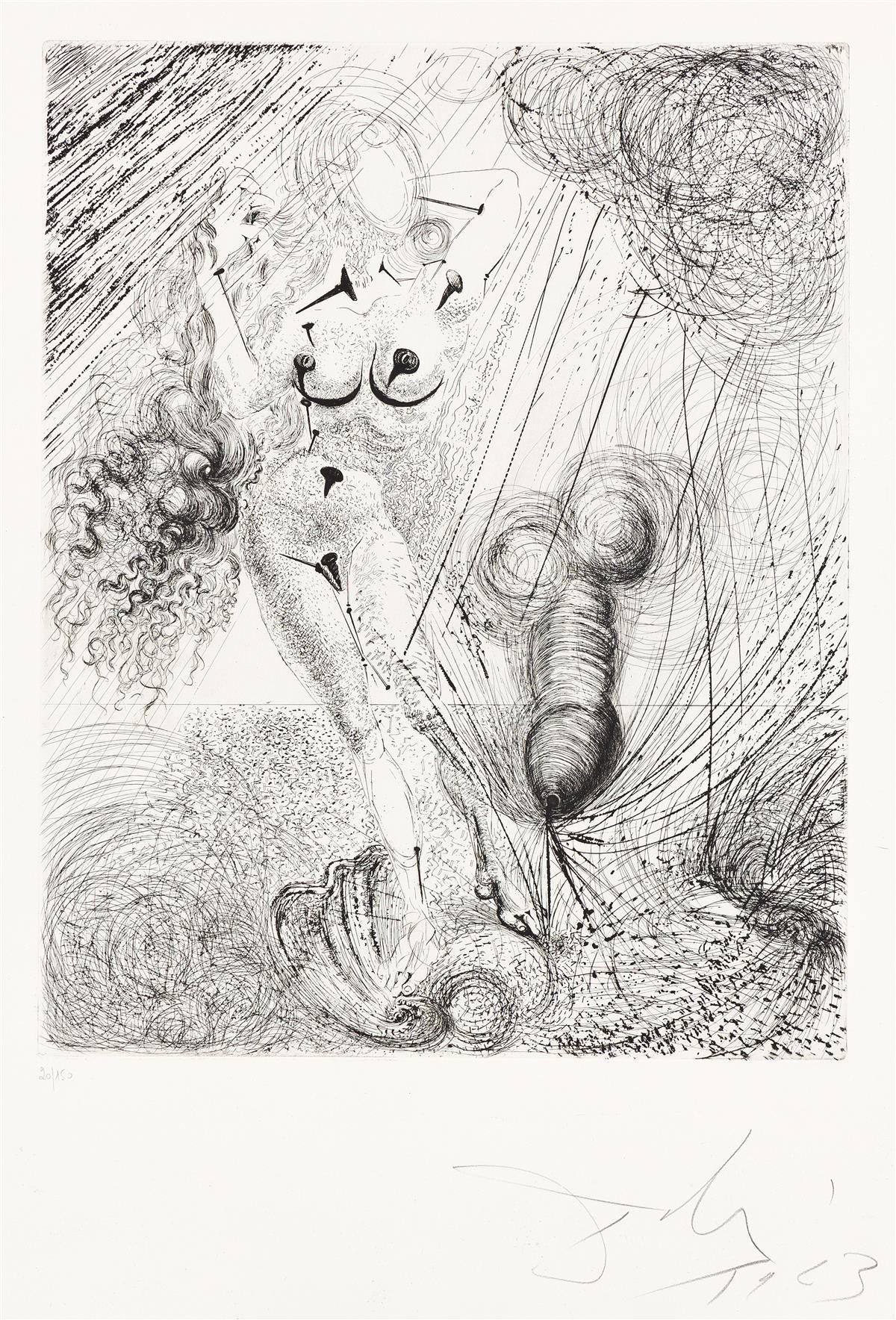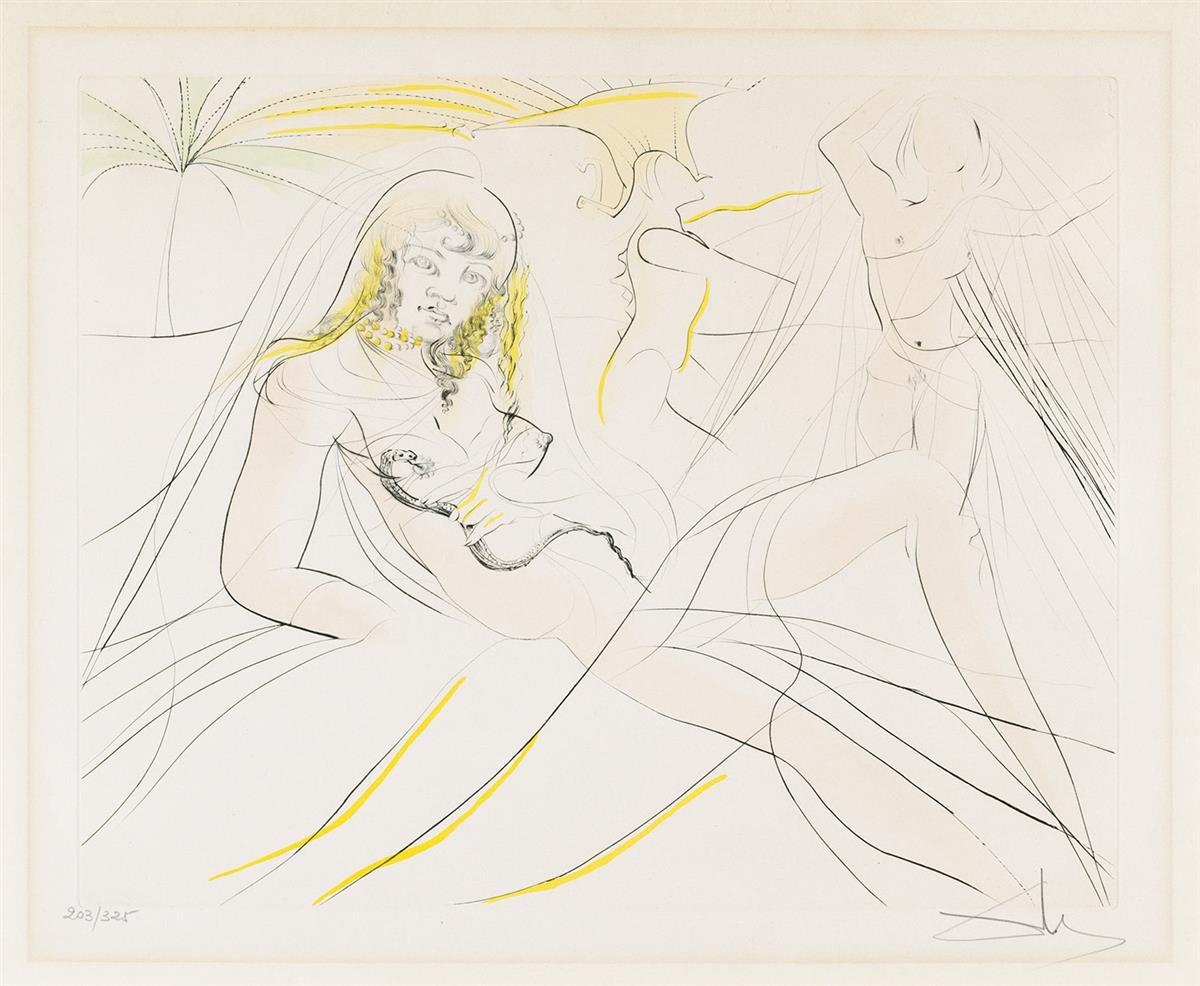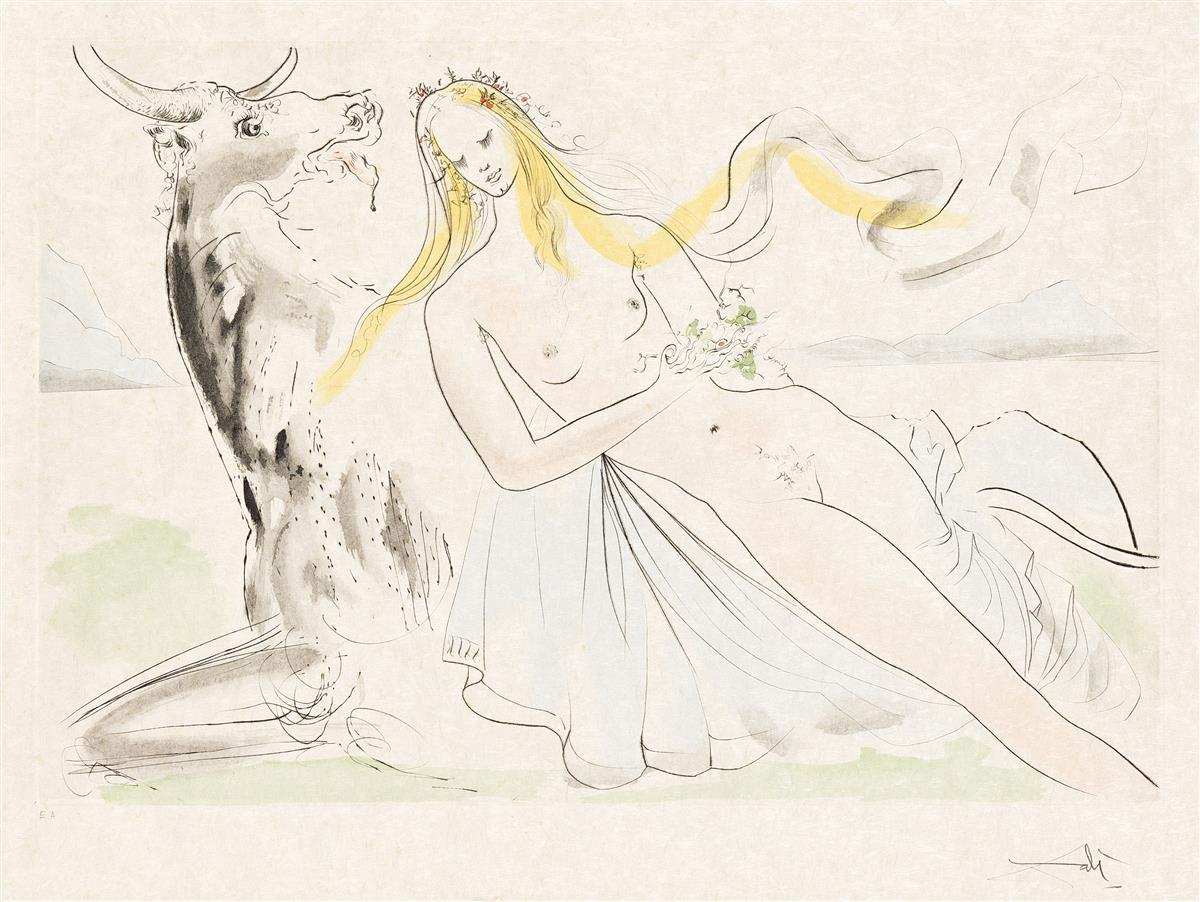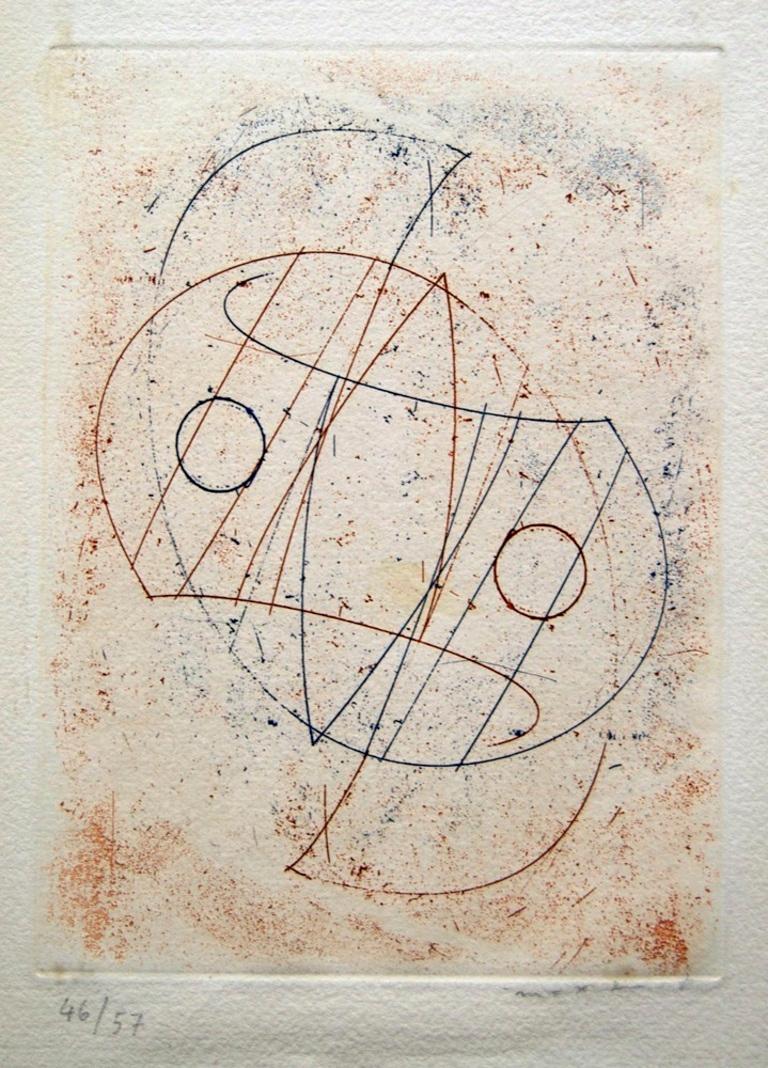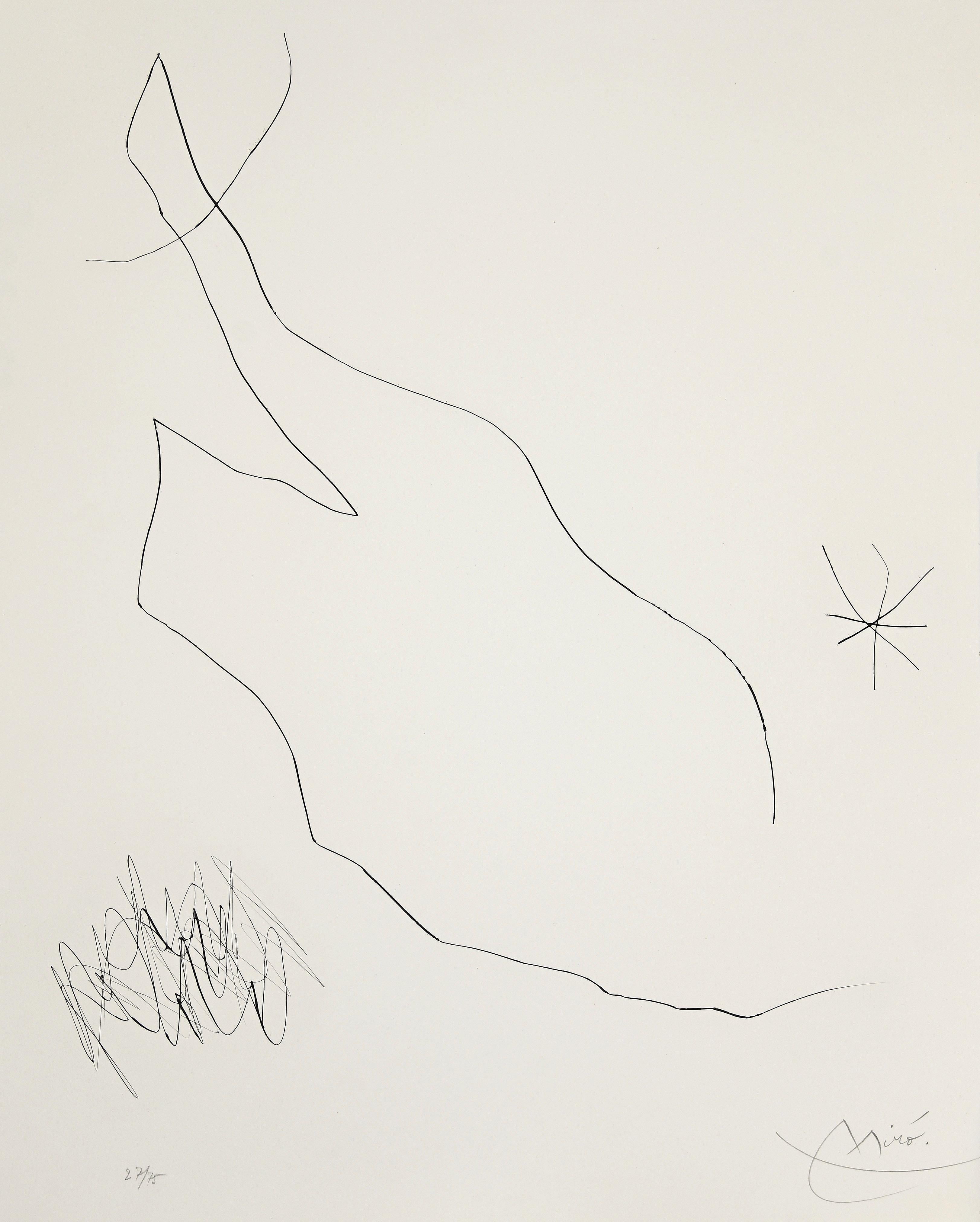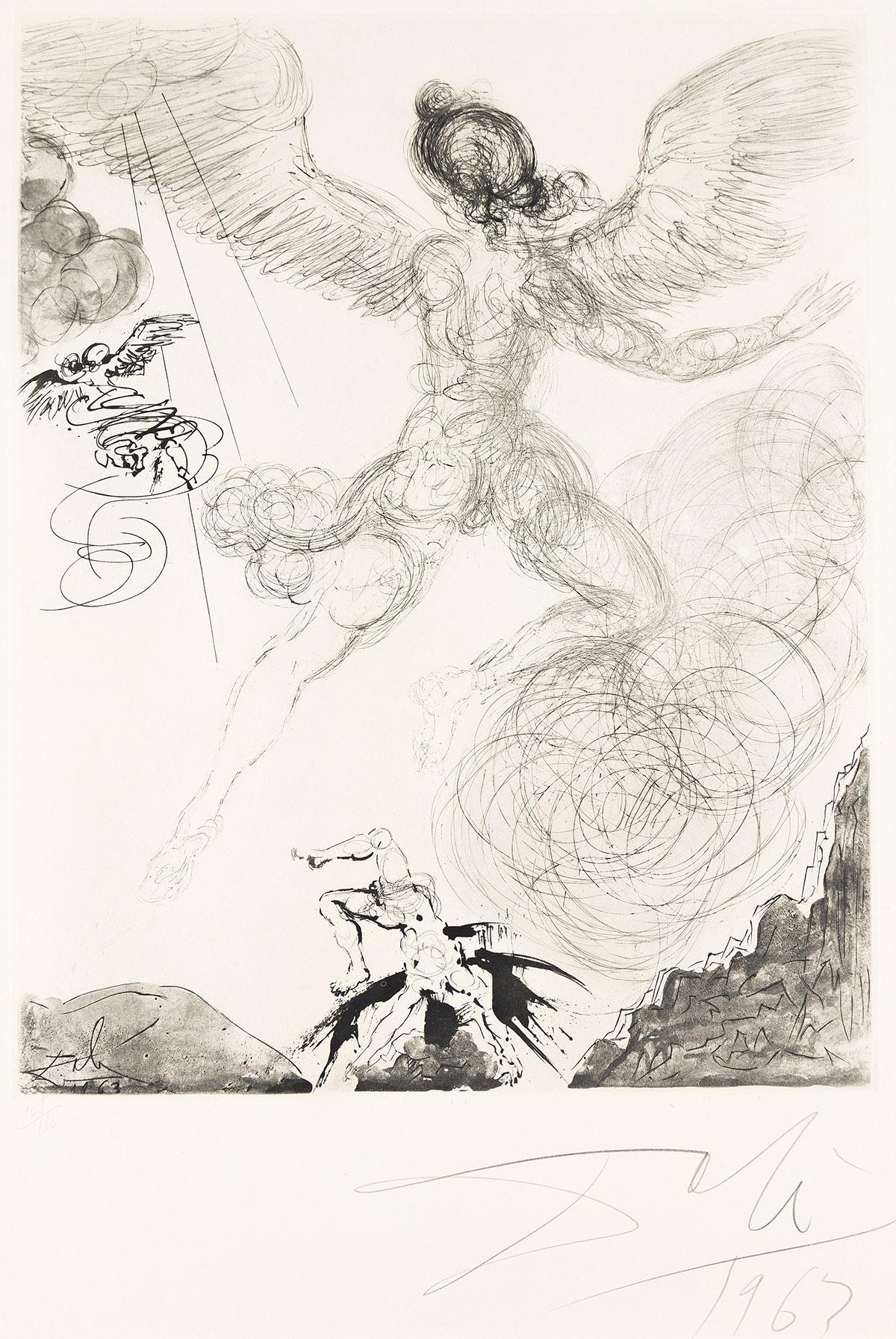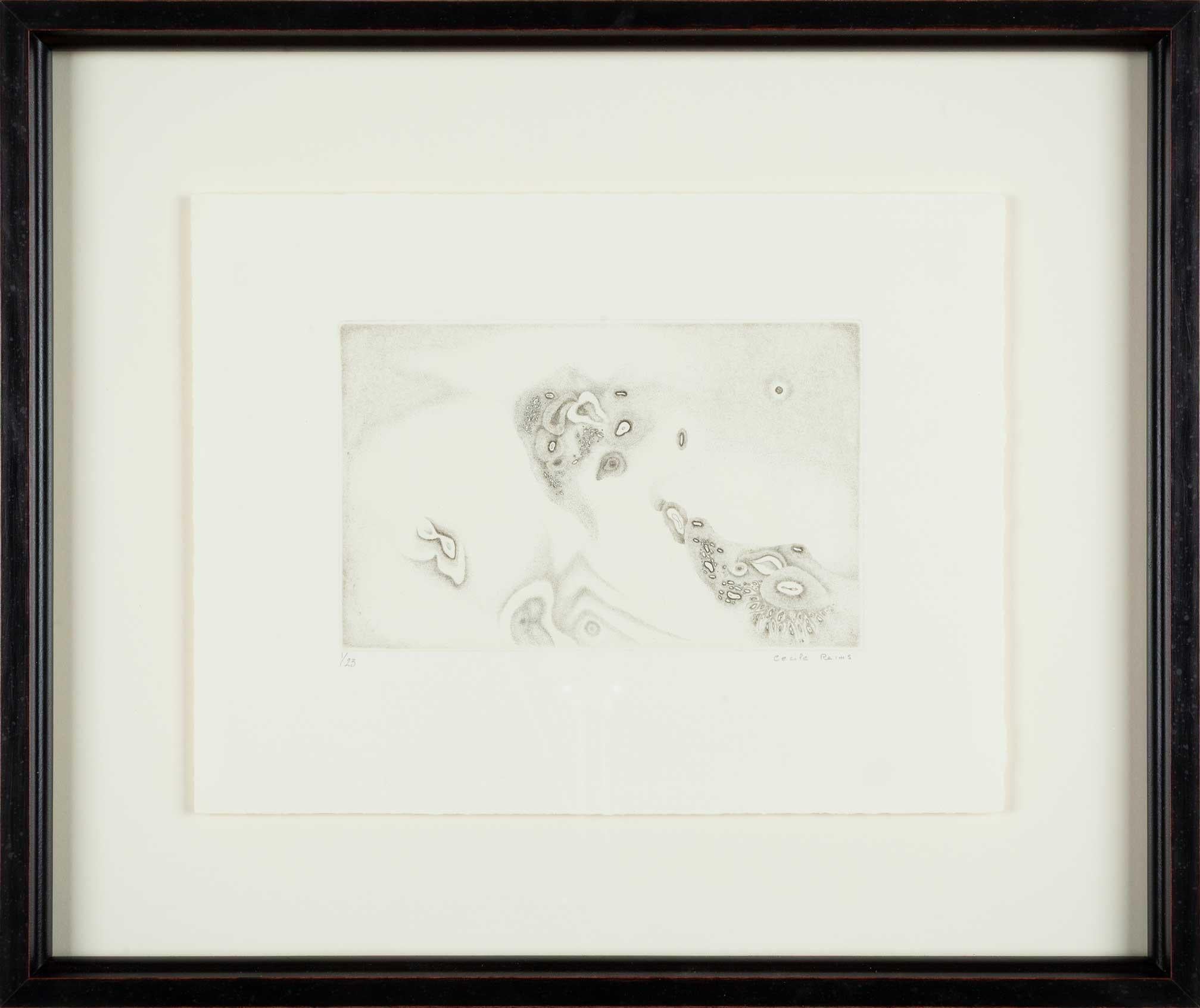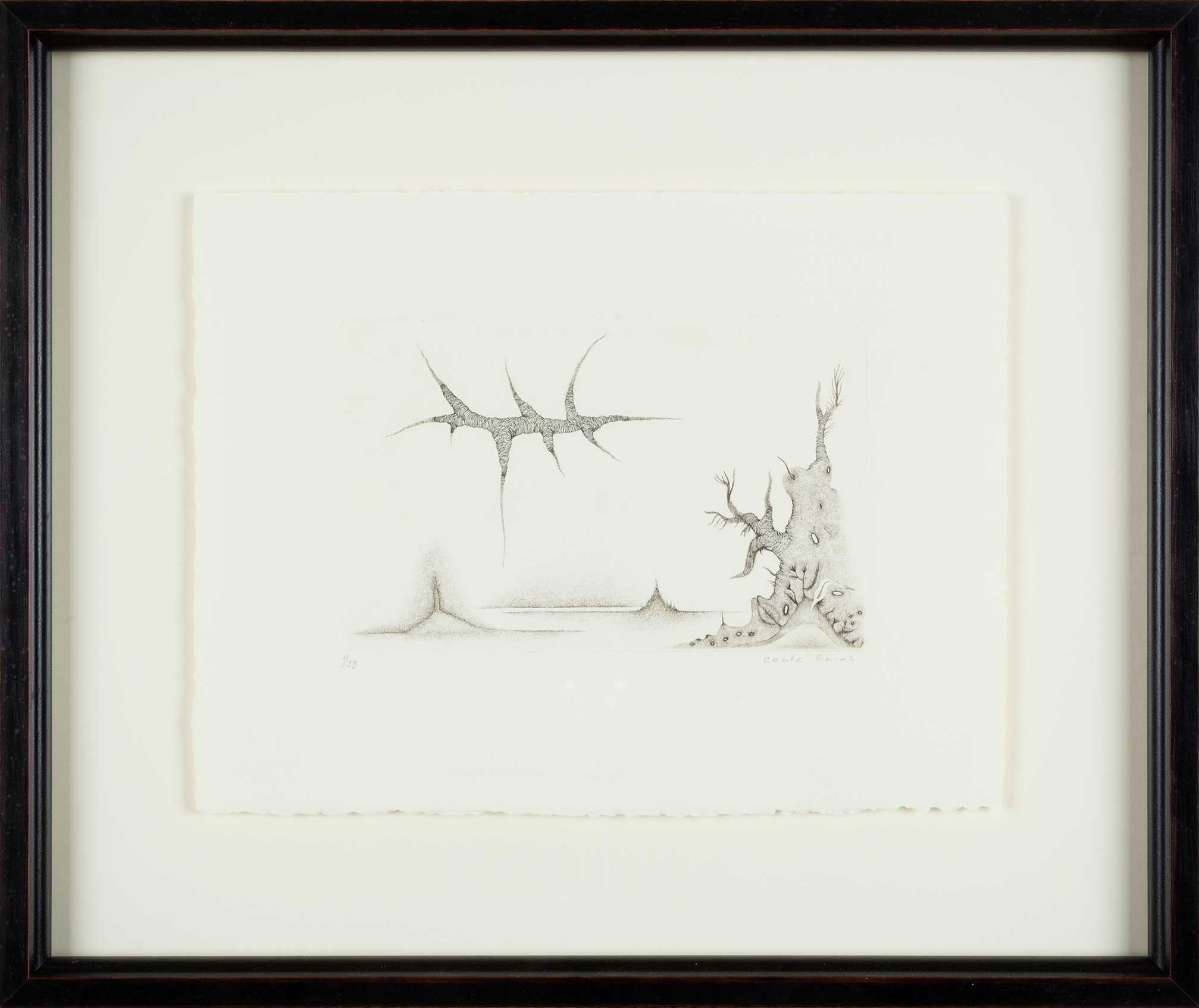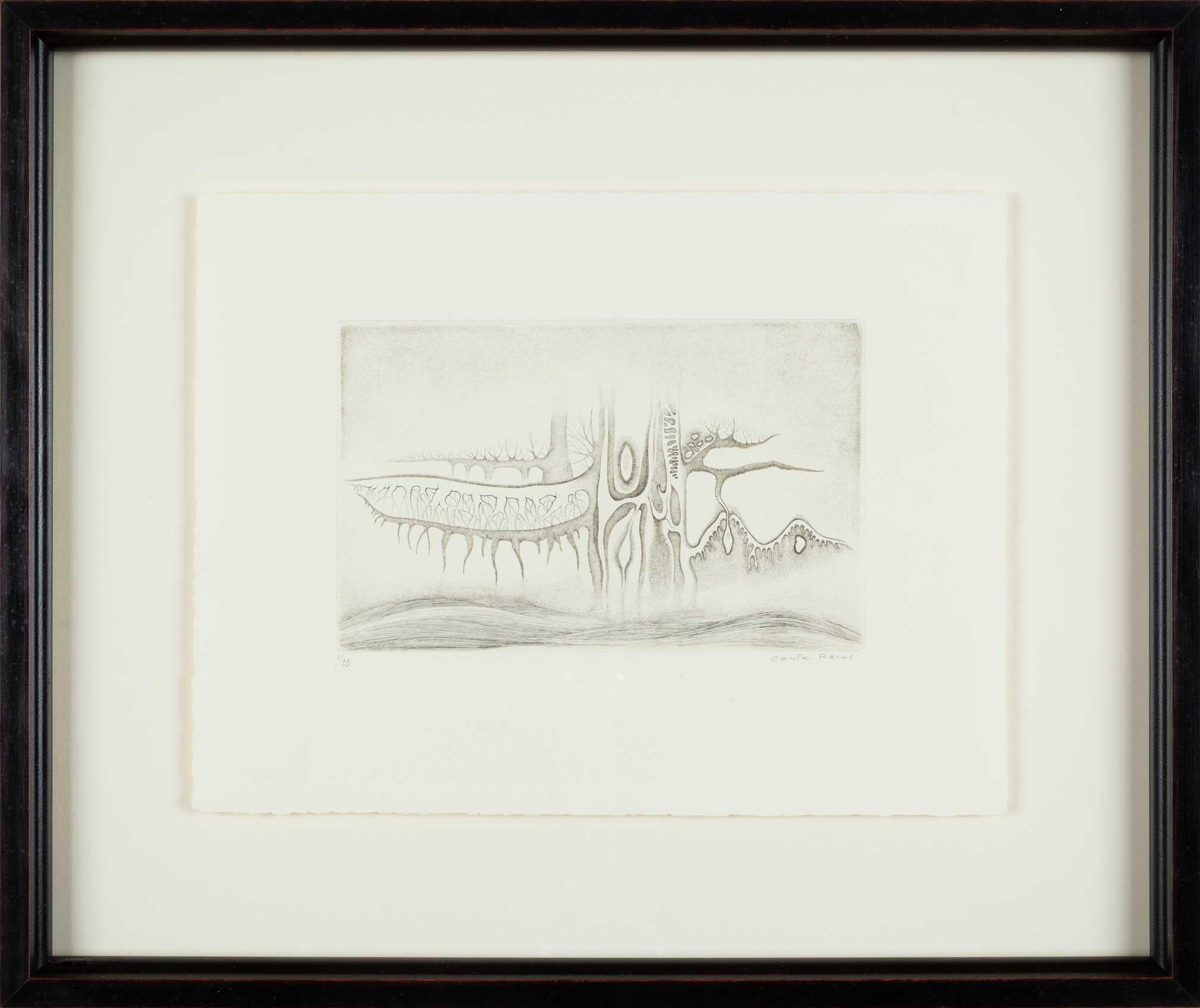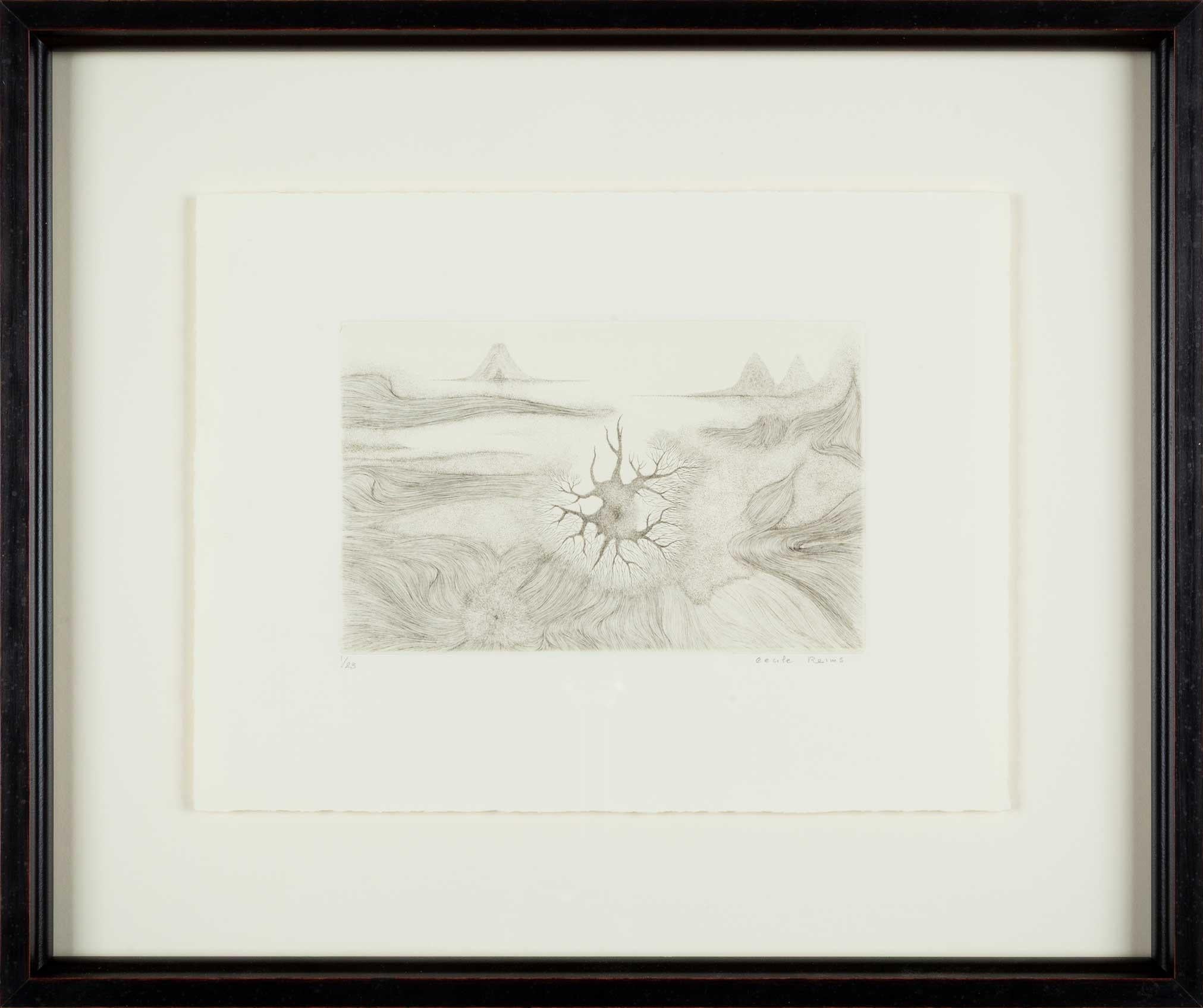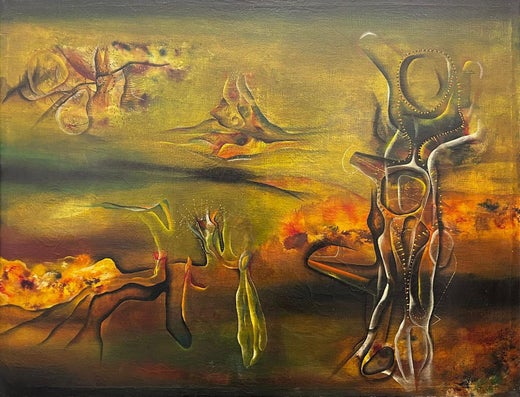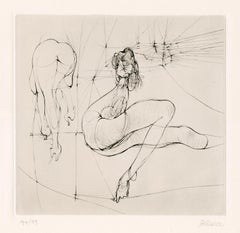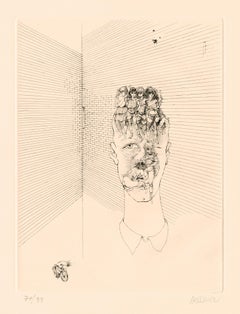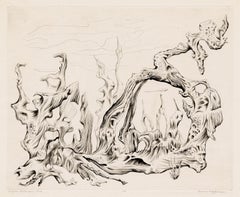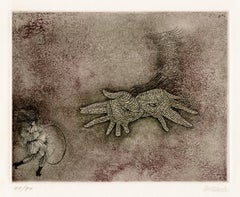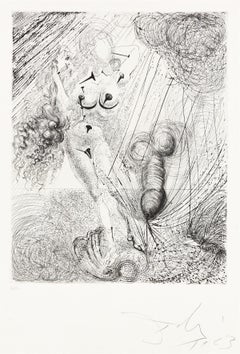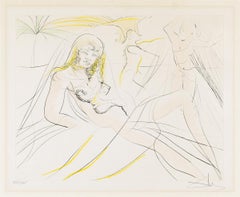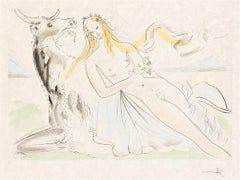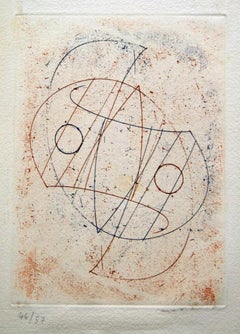
Surrealist Abstraction II
View Similar Items
Want more images or videos?
Request additional images or videos from the seller
1 of 3
Gerome KamrowskiSurrealist Abstraction II1946
1946
About the Item
- Creator:Gerome Kamrowski (1914-2004, American)
- Creation Year:1946
- Dimensions:Height: 5 in (12.7 cm)Width: 5.94 in (15.09 cm)
- Medium:
- Movement & Style:
- Period:
- Condition:
- Gallery Location:Myrtle Beach, SC
- Reference Number:Seller: 1015911stDibs: LU53234192582
Gerome Kamrowski
Gerome Kamrowski was born in Warren, Minnesota, on January 19, 1914. In 1933 Kamrowski was awarded a scholarship to the Art Students League, where he would study in New York under Hans Hofmann. Kamrowski decided to remain in New York for a short time, to attend classes taught by George Grosz. After a few weeks, he returned to St. Paul, and found a position in the mural painting division of the Minnesota WPA. In 1937 Kamrowski went to Chicago to study under László Moholy-Nagy and Alexander Archipenko at the New Bauhaus. There he was exposed to new and interesting ideas regarding the role of nature in art and the "geometric basis of natural form". In 1938 Kamrowski received a Guggenheim fellowship to attend Hans Hofmann's summer school in Provincetown, Massachusetts. He then relocated to New York where he met William Baziotes. Together they shared a fascination in Surrealist automatic writing, and both artists explored its possibilities in their paintings. Kamrowski was particularly drawn to Surrealism's fundamental appeal of intuition over intellect. He was interested seeking a process that "binds all things together...a kind of cosmic rhythm". Throughout the late 1930s and early 1940s while living in New York, Kamrowski became an integral part of the emerging surrealists. In 1942, the artist Roberto Matta attempted to form a group of artists to investigate new applications for Surrealist methods. He invited Kamrowski, along with William Baziotes, Jackson Pollock, Peter Busa, and Robert Motherwell to join. No matter how short lived the collaboration was, this group was the kernel of the open-ended movement that was referred to as abstract surrealism and would over time prove to be the beginnings of abstract expressionism. It was during this time, the winter of 1939/1940, that an amazing collaboration was made. Kamrowski and two of his contemporaries, Baziotes and Pollock, came together and began to paint. This painting was a pivotal work, showing the transition from, and fusion of, Surrealism to Action Painting and Abstract Expressionism. In 1947, Kamrowski was invited to the Surrealist Exhibition in Paris by Surrealist leader André Breton. Breton said of him, "Of all the young painters whose evolution I have been able to follow in New York during the last years of the war, Kamrowski is the one who has impressed me far the most by reason of the "quality" and sustained character of his research." In the 1940s Kamrowski relocated to Ann Arbor, Michigan in order to teach at the University of Michigan School of Art. It was a career that would span 38 years, and would encourage countless others to push their artistic boundaries. Teaching became a second passion. Over the years, Kamrowski's energy and drive never faltered, and his style continued to evolve dynamically from the abstract intellectual exercises of the past to colorful 3D pieces often made of glass, cement, and found objects. He worked every day and exhibited steadily in Michigan and elsewhere.
About the Seller
5.0
Recognized Seller
These prestigious sellers are industry leaders and represent the highest echelon for item quality and design.
Platinum Seller
Premium sellers with a 4.7+ rating and 24-hour response times
Established in 1995
1stDibs seller since 2016
297 sales on 1stDibs
Typical response time: 1 hour
Associations
International Fine Print Dealers Association
Authenticity Guarantee
In the unlikely event there’s an issue with an item’s authenticity, contact us within 1 year for a full refund. DetailsMoney-Back Guarantee
If your item is not as described, is damaged in transit, or does not arrive, contact us within 7 days for a full refund. Details24-Hour Cancellation
You have a 24-hour grace period in which to reconsider your purchase, with no questions asked.Vetted Professional Sellers
Our world-class sellers must adhere to strict standards for service and quality, maintaining the integrity of our listings.Price-Match Guarantee
If you find that a seller listed the same item for a lower price elsewhere, we’ll match it.Trusted Global Delivery
Our best-in-class carrier network provides specialized shipping options worldwide, including custom delivery.More From This Seller
View AllUntitled (Two Nudes) — Erotic Surrealism
By Hans Bellmer
Located in Myrtle Beach, SC
Hans Bellmer, Untitled (Two Nudes), engraving and drypoint, 1971, edition 99. Signed and numbered '94/99' in pencil. A fine impression, on Arches cream wove paper; the full sheet wit...
Category
1960s Surrealist Abstract Prints
Materials
Engraving, Drypoint
'Blue Eyes' — Erotic Surrealism
By Hans Bellmer
Located in Myrtle Beach, SC
Hans Bellmer, 'Blue Eyes', engraving and drypoint, edition 99, 1971. Flahutez 89. Signed and numbered '74/99' in pencil. A fine impression, on Arches cream wove paper; the full sheet...
Category
1960s Surrealist Abstract Prints
Materials
Engraving, Drypoint
'European Landscape' —Mid-century American Surrealism
By Lawrence Kupferman
Located in Myrtle Beach, SC
Lawrence Kupferman, 'European Landscape', drypoint, edition 50, 1942. Signed, dated, titled, and numbered '7/50' in pencil. A superb, finely nuanced impression, on cream wove paper; the full sheet with margins (1 to 1 3/4 inches); in excellent condition.
Image size 10 7/8 x 13 3/8 inches; sheet size 13 1/8 x 16 1/2 inches. Archivally matted to museum standards, unframed.
An impression of this work is included in the permanent collection of the Syracuse University Art Museum.
ABOUT THE ARTIST
Lawrence Kupferman (1909 - 1982) was born in the Dorchester neighborhood of Boston and grew up in a working-class family. He attended the Boston Latin School and participated in the high school art program at the Museum of Fine Arts, Boston. In the late 1920s, he studied drawing under Philip Leslie Hale at the Museum School—an experience he called 'stultifying and repressive'. In 1932 he transferred to the Massachusetts College of Art, where he first met his wife, the artist Ruth Cobb. He returned briefly to the Museum School in 1946 to study with the influential expressionist German-American painter Karl Zerbe.
Kupferman held various jobs while pursuing his artistic career, including two years as a security guard at the Museum of Fine Arts, Boston. During the 1930s he worked as a drypoint etcher for the Federal Art Project, creating architectural drawings in a formally realistic style—these works are held in the collections of the Fogg Museum and the Smithsonian American Art Museum. In the 1940s he began incorporating more expressionistic forms into his paintings as he became progressively more concerned with abstraction. In 1946 he began spending summers in Provincetown, Massachusetts, where he met and was influenced by Mark Rothko, Hans Hofmann, Jackson Pollock, and other abstract painters. At about the same time he began exhibiting his work at the Boris Mirski Gallery in Boston.
In 1948, Kupferman was at the center of a controversy involving hundreds of Boston-area artists. In February of that year, the Boston Institute of Modern Art issued a manifesto titled 'Modern Art and the American Public' decrying 'the excesses of modern art,' and announced that it was changing its name to the Institute of Contemporary Art (ICA). The poorly conceived statement, intended to distinguish Boston's art scene from that of New York, was widely perceived as an attack on modernism. In protest, Boston artists such as Karl Zerbe, Jack Levine, and David Aronson formed the 'Modern Artists Group' and organized a mass meeting. On March 21, 300 artists, students, and other supporters met at the Old South Meeting House and demanded that the ICA retract its statement. Kupferman chaired the meeting and read this statement to the press:
“The recent manifesto of the Institute is a fatuous declaration which misinforms and misleads the public concerning the integrity and intention of the modern artist. By arrogating to itself the privilege of telling the artists what art should be, the Institute runs counter to the original purposes of this organization whose function was to encourage and to assimilate contemporary innovation.”
The other speakers were Karl Knaths...
Category
1940s Surrealist Abstract Prints
Materials
Drypoint
'Child and Seeing Hands' — after the artist's 1948 Surrealist masterwork
By Hans Bellmer
Located in Myrtle Beach, SC
Hans Bellmer, 'Child and Seeing Hands', photogravure and engraving, edition 9, 1970. Flahutez 4-9. Signed by the artist and numbered '41/90' in pencil. A superb, richly-inked impress...
Category
1670s Surrealist Abstract Prints
Materials
Engraving, Photogravure
Small Forms On Crossing Bands
By Werner Drewes
Located in Myrtle Beach, SC
Werner Drewes, 'Small Forms on Crossing Bands', drypoint and roulette, 1935, edition 20, Rose 1.197. Signed in pencil. A fine, rich impression, in warm black ink, on cream wove paper...
Category
1930s Bauhaus Abstract Prints
Materials
Drypoint
'Cheerleader' — Mid-century American Surrealism
By Robert Vale Faro
Located in Myrtle Beach, SC
Robert Vale Faro, 'Cheerleader', wood engraving, 1945, edition 15. Signed, dated, titled, and numbered '104' (the artist's inventory number) and '8/15' in pencil. A fine, black impression, with full margins (1 1/2 inches), on heavy, cream wove paper, in excellent condition. Scarce. Matted to museum standards, unframed.
ABOUT THE ARTIST
Robert Vale Faro (1902-1988) was a well-known modernist architect and artist associated with the Chicago Bauhaus...
Category
1940s Surrealist Abstract Prints
Materials
Woodcut
You May Also Like
Aphrodite
By Salvador Dalí
Located in New York, NY
A very good, richly-inked impression of this Drypoint and aquatint printed in gray and black on cream wove paper. Signed, dated and numbered 20/150 by Dali. Printed by Robbe, Paris. ...
Category
1960s Surrealist Abstract Prints
Materials
Drypoint
Cleopatra
By Salvador Dalí
Located in New York, NY
A very good impression of this large color drypoint with strong colors. Signed and numbered 203/325 in pencil by Dali.
Catalogue reference: Michler/Löpsinger 820; Field 72-14.
Category
1970s Surrealist Abstract Prints
Materials
Color, Drypoint
Le Viol d'Europe
By Salvador Dalí
Located in New York, NY
A very good impression of this color drypoint on Japon nacré. Artist's proof, aside from the edition of 270. Signed and inscribed "EA" in pencil. Published by Vision Nouvelle, Paris....
Category
1970s Surrealist Figurative Prints
Materials
Color, Drypoint
Obliques - Drypoint by Max Ernst - 1967
By Max Ernst
Located in Roma, IT
"Obliques" is an etching hand-signed and numbered etching realized by Max Ernst in 1967. This is an edition of 57 prints. Passepartout included. Very good condition.
Published by Ge...
Category
1970s Surrealist Abstract Prints
Materials
Drypoint
Journal D'Un Graveur - Vol. 2 Plate 5 - Etching by J. Mirò - 1975
By Joan Miró
Located in Roma, IT
This is an original etching and drypoint realized by Joan Miró in 1975. Hand signed in pencil on the lower right and numbered on the lower left.
Edition of 75 prints. It represents ...
Category
1970s Surrealist Abstract Prints
Materials
Drypoint, Etching
Journal d'un Graveur - Vol. 2 Plate 10 - Etching by J. Mirò - 1975
By Joan Miró
Located in Roma, IT
This is an original etching and drypoint realized by Joan Miró in 1975.
Hand signed in pencil on the lower right and numbered on the lower left.
Edition of 75 prints.
It represent...
Category
1970s Surrealist Abstract Prints
Materials
Drypoint, Etching
